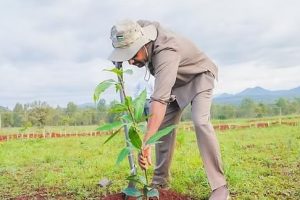Ethiopia is believed to have the largest livestock population in Africa. The livestock subsector makes the major contribution to the overall economy of the country. The subsector accounts for about a fifth of the Gross Domestic Product (GDP) and generates foreign exchange.
Sectorally, it contributes to a third of the agricultural GDP without taking its indirect contributions into account. With the rapidly growing population, increasing urbanization, and rising incomes, the domestic demand for animal products is projected to significantly increase in the near future. According to Mohammed Adem, the livestock production system in Ethiopia is traditional and contributes to cash generation for subsistence.
Hide is the raw skin of mature animals of larger kinds, such as cattle and other large animals. Skin is obtained from fully grown animals of smaller kinds. Hide and skin subsector is constrained by various structural, production, information and quality problems. It also faces financial constraints. The opportunities of hides and skins subsector in Ethiopia are availability of raw material and the existence of large livestock base in pastoral areas. There is a growing national and international market for hides and skins. Knowledge and information have to be provided and disseminated to producers and collectors of hides and skins to improve the quantity and quality of the products to fetch better prices.
In Ethiopia, agricultural development, including hide and skin subsector, has been prioritized by the government for stimulating overall economic growth, reducing poverty, and achieving food security. According to MOFED, the agricultural sector of Ethiopia accounts for about 34 percent of the GDP, more than 80 percent of the export, and 85 percent of the employment opportunities. Within agriculture, the livestock subsector provides an opportunity for further development. The total size of the national livestock herd, being one of the largest in Africa, makes it replete with the potential to contribute significantly to national development and poverty reduction.
With the rapidly growing population, increasing urbanization, and rising incomes, the domestic demand for meat, milk, and eggs is expected to increase significantly in the foreseeable future. Furthermore, the country’s foreign exchange from livestock product has been on the rise through exporting of red meat to the Gulf Countries and providing leather and other livestock product to Europe.
The livestock production system is largely traditional and animals are sold or slaughtered only at an advanced age, or in the case of urgent need. Self-sufficiency in food production and increase in rural income and foreign currency earning of the country through improving the quality and quantity of export items are among the main objectives of the current agricultural development policies and programs of Ethiopia.
Cattle, sheep, and goats are important sources of income for the agricultural community and together comprise one of Ethiopia’s major sources of foreign currency earning through export of “live” animals, meat, hide, and skin as explained by H. Desta. Hides and skins could be obtained from fish, birds, and reptiles as well as from wild and domesticated animals.
The most important sources are cattle, sheep, and goats. Cattle hides, sheep skins and goatskins are raw materials for the leather industry which are mainly derived from local areas of the country. According to FAO, hides and skins as well as live animals are important economic products contributing to the largest share of the total agricultural export commodities of Ethiopia.
As mentioned earlier, hides and skins are among the major foreign exchange earners for the country. The availability of hides and skins through slaughtering or death of livestock is of particular importance to the leather industry. Although today it ranks fourth, next to coffee, chat, and oilseed export, in the previous decades it used to be the second highest foreign currency earner after coffee.
Ethiopia also earned foreign exchange from the export of “finished” leather, shoes, garments, and gloves to foreign customers. Despite its potential, hide and skin performed weakly not only in the production sector but also in the marketing sector. These issues led to further studies on its production and marketing trends with a view to earn more foreign exchange.
The studies assessed hide and skin production and the marketing trends in Ethiopia. Usually, the objectives of these studies may be summed up as review of the hide and skin production, marketing trend, constraints and opportunities. The studies begin with the definition of hide and skins, which are often used interchangeably.
Hides are categorized based on the age and weight of animals. Accordingly, calf skins are usually grouped on the basis of low weight. Hides of big animals are categorized as light, medium, and heavy. Light category hides refer to young heifers or bulls. Medium category hides are related to young cows and bulls. Heavy hides are obtained from full-grown cows or bulls.
Sheep skins are divided into hairy and wool types. Goatskins are highly valued as a raw material because of the demand for superior-quality leathers. Hide and skin production is commonly practiced as an additional activity of farmers, who do not specialize in this activity.
The emergence of modern tanning in Ethiopia started with the establishment of modern tanneries. The leather is one of the growing economic subsectors in Ethiopia. However, the subsector is constrained by different issues like external skin parasites, inappropriate treatment of animals, faults and abuses during slaughtering, and improper handling of skin before reaching the tannery.
The subsector is losing a large amount of revenue due to the decline in quality that causes a fall in export earnings. Currently, several tanneries produce all forms of hides and skins and finished leather for the domestic and export markets.
These tanneries have soaking capacities for sheep skin, goatskin, and hides. Regarding small farmers, the production of hide and skin has multipurpose. It is primarily used for income generation and then used as bed mattress or cover in the rural areas. Ethiopian small sheep skins have high demand in the global leather market due to their fine and compact structure. The capacity to process hides and skins greatly “exceeds” domestic supply, particularly for raw sheepskins and goatskins.
Supply is affected by the quality of hide and skin which is related to the damage done to the outer surface. It is estimated that about one quarter to one-third of all the skins processed at tanneries are unsuitable for export due to various defects.
According to Y. Abadi, the major problem affecting the tanning industry is related to skin diseases, scratches, scabs, and branding, poor pattern and cuts, decomposed and poor substances. Because of annual wastage rates for cattle, sheep, and goats, production was reduced. The percentage of skins having defects, which downgraded the quality, has increased tremendously in Ethiopia.
Skin quality is primarily defined by the absence of damage to the layer of the skin. Tanneries report that only about a tenth of the harvested skins qualify for top grades. The rest are downgraded and sometimes even rejected. The “quality” of finished leather is related to a number of surface and structural defects. According to C. Kidanu the hide and skin acquire defects in the life of the animal, and during slaughtering, storage, and transportation stages. The causes of defects on raw hide and skin can be broadly classified as pre-slaughter and post-slaughter deficiency.
Most of the hides and skins are obtained from household slaughters during holidays. A small part is obtained from major urban slaughterhouses and abattoirs. Rural and urban operators collect a sizable volume of hides and skins. These operators use poorly equipped slaughter houses built from concrete slabs, under a shade.
Sometimes, they use poles for hoisting sheep or goat carcasses. The hides and skins are not marketable as required due to their low quality. Those persons engaged in the slaughtering of sheep are mainly interested in the sale of mutton in their shops. They do not give “attention” to the quality of hides and skins which they consider only a byproduct. These hides and skins may be thrown to the backyard of the butcher shops.
The hides and skins from the households are normally collected by hides and skins traders. The actual market supply of hides and skins is far below the production potential. The hides and skins are processed by tanneries into semi-finished or finished leather for local and export markets. However, the hides and skins unutilized by local tanners may be smuggled into neighboring countries. Though there is lack of information, the proportion of hides and skins wasted without any use, and those subjected to illicit trade, could not be indicated. It is believed that quite a considerable number of local tanners found in the regions of the country make use of the raw material as well.
Hides and skins production and marketing face several constraints in Ethiopia. According to G. Admasu, these constrains are reflections of the economic policies which are socialist-oriented. The main constraints in the marketing of hides and skins included “inadequate” network of primary buyers. The lack of facility for slaughtering, preservation, storage, transportation, and prevention of disease and parasite are also problems of the subsector.
Moreover, lack of “incentives” for government extension agents is also a major constraint as it affects effective and efficient production, delivery and marketing of hides and skins in the country. These agents are the main factors for the transmission of knowledge on the need for quality of products to compete in the market.
The main constraints adversely affecting the production and marketing of hides and skins are shortage of raw material, quality deterioration, lack of incentive to supply good-quality raw material to suppliers, and inadequate numbers of slaughterhouses. However, the gap between demand and potential supply is the factor that affects the production and marketing of hide and skin in Ethiopia.
The main constraints in the marketing of hides and skins included inadequate storage and preservation facilities. Factors adversely affecting the production and utilization of hides and skins include poor animal husbandry practices and lack of training on production and marketing of hides and skins.
BY GETACHEW MINAS
The Ethiopian Herald May 13/2021





